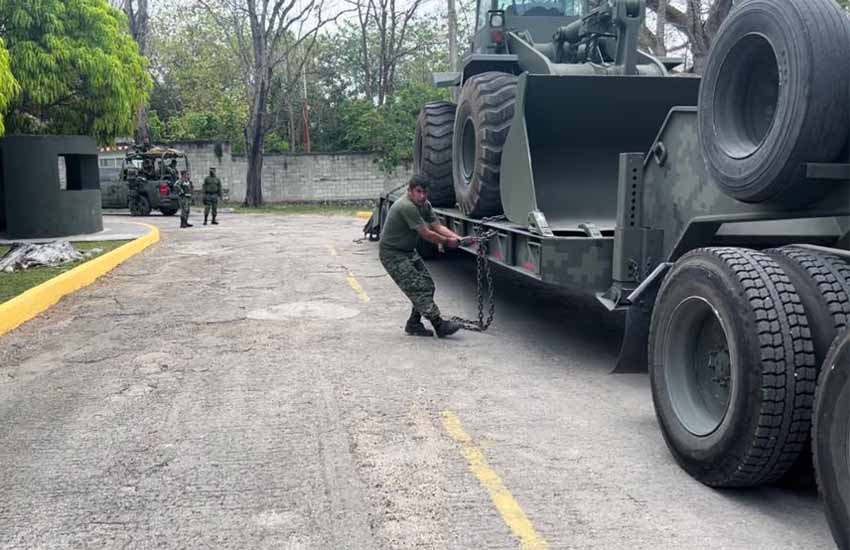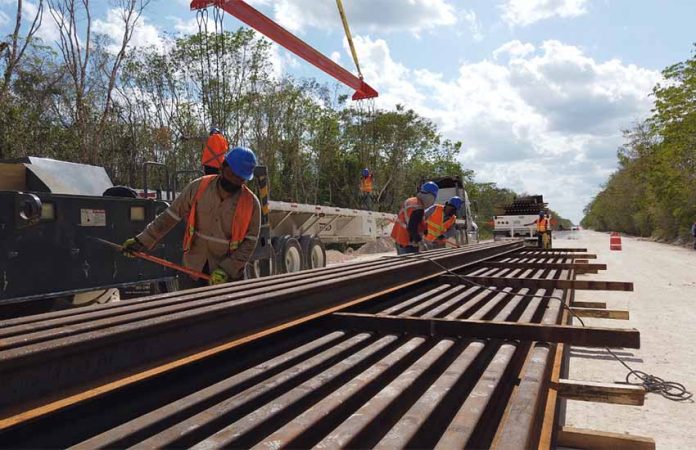The Maya Train railroad won’t open while the current federal government is in office — as President López Obrador has pledged — and may never be finished, according to two people working on the ambitious project.
A civil engineer working on section 4 of the project and an archaeologist working on section 3 spoke with Yucatán Magazine about the construction of the US $10 billion, 1,500-kilometer railroad, which the government says will begin operations in 2023. Both spoke on the condition of anonymity to avoid repercussions.
The engineer said that work on section 4, which will run between Izamal, Yucatán, and Cancún, Quintana Roo, is “extremely behind schedule.”
“The official delay is five months, but in reality, at this rate, we are more like a year and a half behind where we should be at this point,” the engineer said.

“… We have simply taken on too much. We have actually been gaining some ground when it comes to clearing vegetation and setting the stage to lay rail, but even there we are behind. And this is to say nothing of other necessary pieces of infrastructure such as overpasses and underpasses, as well as the train stations.”
Asked how long it will take to make AMLO’s vision a reality, the engineer responded:
“Honestly, we are looking at somewhere between eight and 10 more years. The thing is that this should not come as a surprise as it’s what we have known since the beginning. We had auditors come from Spain, and that’s the timeline they gave us.”
Probed as to whether the project will ultimately be finished or abandoned, the engineer said the election last Sunday of a Morena party governor in Quintana Roo “bodes well for the project” as Yucatán will be the only state among the five through which the railroad will run without a ruling party leader.
“But ultimately it will come down to who the next president will be and if they decide to continue with the project or simply abandon it,” the engineer said.
The archaeologist told Yucatán Magazine that working on section 3, which will run between Calkiní, Campeche, and Izamal, Yucatán, has been a rewarding experience but one filled with many complications.
“… We really have come across some very interesting finds and are quite excited to see what else we come across during construction. There is much criticism of the project with regard to its potential destruction of cultural heritage, but I can tell you that all the parties involved are being extremely careful and conservative in this respect,” the archaeologist said.
“… I love the work, but honestly, there is more than enough work just in … [section] 3 of the project for an entire six years. I very much doubt we will be able to finish … on time.”

The archaeologist claimed that the project is “riddled with bureaucracy and nepotism” and that the people calling the shots “have no idea what is really going on.”
“… Other than that, … it’s … simply an impossible amount of work. I will give you an example: there is a huge amount of rail sitting on the outskirts of Maxcanú [in Yucatán] at the moment. The person in charge of procuring the vehicles to transport them to the worksites had no idea what he was doing and contacted a friend’s fleet of trucks to move them. To make a long story short, the rails proved too heavy, and they are just sitting there.”
In deciding to build the Maya Train and other large-scale infrastructure initiatives, López Obrador committed to “overly ambitious projects, which in the end are likely to be unfinished,” the archaeologist said.
Another Maya train section that could hold up completion of the overall project is Tramo 5 Sur, as the southern portion of the Cancún-Tulum stretch is known. A federal judge last month issued a definitive suspension order against the section due to the absence of an authorized environmental impact statement (EIS).
At a public meeting in Tulum on Tuesday that was arranged by the federal Environment Ministry as part of the EIS consultation process, people opposed to the Maya Train claimed that the document isn’t valid as it doesn’t fully consider the environmental impact of the project and lacks key information such as technical studies.
Activists also questioned an official with the National Institute of Ecology (Inecol), which completed the as-yet unapproved EIS, why jungle was cleared for the construction of Tramo 5 Sur before all required studies were completed and approved.
Inecol official Rafael Villegas Patraca referred the question to an official with the National Tourism Promotion Fund, which is managing the Maya Train project, but he repeatedly avoided answering it, the newspaper Reforma reported.
Environment Minister María Luisa Albores acknowledged last month that sections 4, 5, 6 and 7 only have provisional approval but asserted that their construction has been able to proceed thanks to an infrastructure decree issued by President López Obrador in November.
With reports from Yucatán Magazine and Reforma
